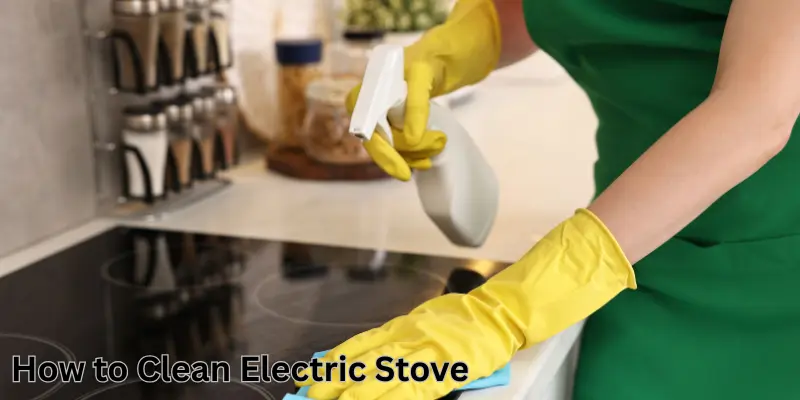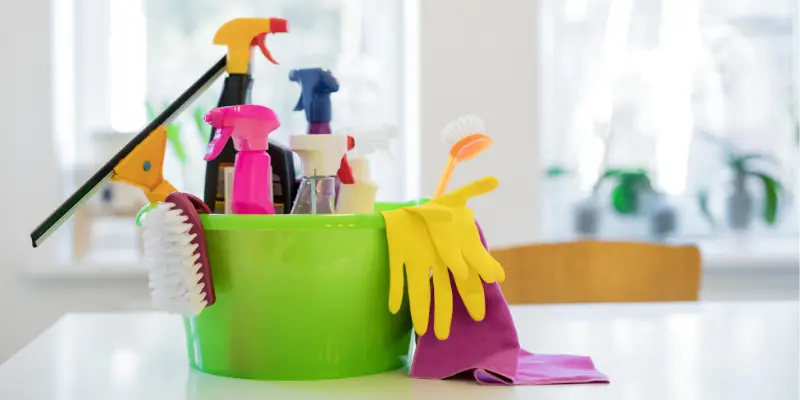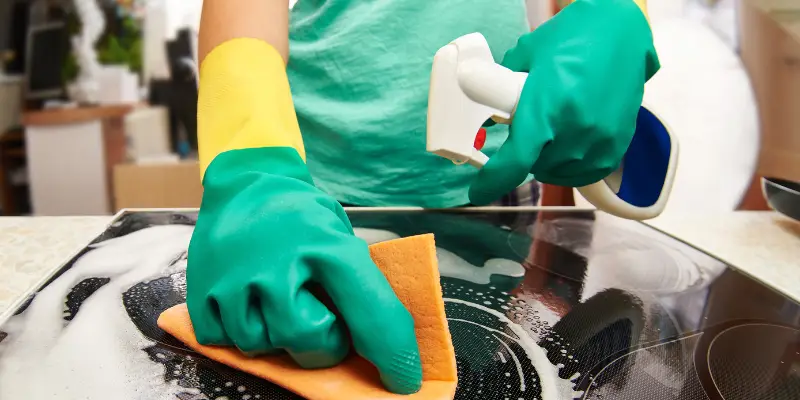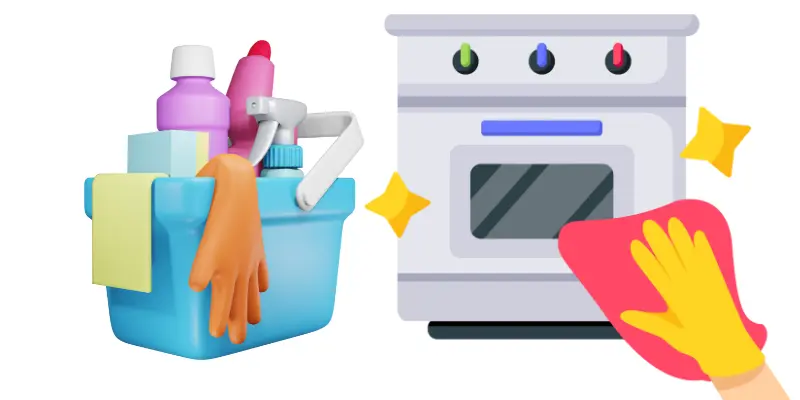How to Clean Electric Stove: Step-by-Step Guide
Updated: 21 Jun 2025
209
Ever noticed how fast your electric stove gets dirty—even after one meal? Greasy spills, burnt food, and stubborn stains pile up quickly. Worse, if left uncleaned, they can damage your stove or even become a fire hazard.
Keeping your stove spotless isn’t just about looks—it’s about safety and efficiency. A dirty stove can affect heat distribution and may cause smoke or bad smells in your kitchen. Learning how to clean electric stove the right way ensures a longer lifespan, better cooking results, and peace of mind.

As cleaning expert Marie Kondo once said, “The objective of cleaning is not just to clean, but to feel happiness living within that environment.”
In this post, you’ll discover safe, simple, and effective methods to clean all types of electric stoves. Plus, you’ll learn about natural cleaners, how often you should clean, and what mistakes to avoid.
Let’s get your kitchen sparkling—without scratching or damaging a thing.
Know Your Electric Stove Type Before You Clean
Not all electric stoves are the same. And cleaning them the same way can cause damage. There are two main types of electric stoves:
- Coil burner electric stoves
- Glass or ceramic electric stoves
Each type needs a different cleaning method. If you’re unsure which one you have, look at the surface. Coils are raised. Glass tops are flat and smooth. Understanding your stove type helps you choose the right method for cleaning. This protects your stove and makes cleaning easier.
Safety First – Things to Do Before Cleaning
Before you clean, make sure your stove is safe to touch and work on. Here’s what you should always do first:
- Turn off the stove completely
- Unplug the power cord or switch off the breaker
- Let the stove cool down fully
- Remove all cookware and loose parts like drip pans and coil burners
- Keep pets and kids away from the area
If you skip these steps, you risk burns or short circuits. Avoid metal scrubbers or knives. They can leave permanent marks.
Learn more about electric stove safety at https://stovemastery.com/electric-stove-safety-guidelines/
Tools and Natural Cleaners You’ll Need
Before you start, gather your cleaning supplies. The right tools make the job faster, safer, and more effective.
Basic Tools:
- Microfiber cloth – soft and lint-free
- Non-scratch sponge – safe for glass stove tops
- Old toothbrush or soft-bristled brush – perfect for corners
- Spray bottle – for easy application of vinegar or homemade solutions
- Plastic scraper – to remove burnt food on ceramic tops
- Rubber gloves – to protect your hands

”You can mix 1 part vinegar and 1 part water in a spray bottle for an all-purpose cleaner. Or make a baking soda paste with water to scrub off burnt residue”. Need extra cleaning power? Add a drop of lemon juice to the mix. It boosts freshness and cutting power.
How to Clean Electric Stove Coil Burners
Coil burners are common in older electric stoves. Cleaning them requires care to avoid damage. Follow this detailed guide:
Step-by-Step Method:
- Turn off and unplug the stove completely.
- Gently remove the coil burners. Pull them straight out.
- Wipe down the coils with a damp cloth. Do not soak them in water.
- If needed, use a toothbrush to clean off stuck debris near the terminals.
- For tough grease, use a cloth dipped in a mix of vinegar and water.
- Let the coils dry completely before reinstalling. Moisture can cause short circuits.
- Wipe the coil sockets (but avoid getting them wet).
- Never soak electric burners. Moisture in the electrical parts can cause permanent damage.
How to Clean Drip Pans on Electric Stove
Drip pans collect everything that spills during cooking. If left dirty, they can smoke and cause bad odors.
Deep Cleaning Method:
- Remove the drip pans and soak them in hot, soapy water for 15–30 minutes.
- After soaking, scrub with a sponge or old toothbrush.
- For stuck-on grease, apply a baking soda paste and spray with vinegar.
- Let it fizz for 5–10 minutes. Then scrub gently.
- Rinse and dry the pans completely before placing them back.
- For burnt stains, you can place the pans in a ziplock bag with ammonia and leave overnight. (Do this outside, and never mix ammonia with other cleaners.)
Pro Tip: Use foil or reusable liners to keep pans clean longer. But don’t cover vents or electric parts.
How to Clean Glass Electric Stove Top Without Scratching

Glass and ceramic stove tops look sleek—but scratch easily. You need the right method and tools to keep them spotless.
Cleaning Glass Stove Top – Step-by-Step:
- Let the stove cool completely. Never clean while it’s warm.
- Wipe loose debris using a dry microfiber cloth.
- Spray the surface with a 50/50 mix of vinegar and water.
- Sprinkle baking soda over the stains and burnt spots.
- Cover the surface with a hot, damp towel for 15 minutes.
- Remove the towel and gently scrub with a non-abrasive sponge.
- Wipe off the residue with a clean cloth.
- Buff dry for a shiny finish.
Note: ”Never use metal scrapers, harsh chemicals, or rough pads. These will scratch or discolor your glass stove top”.
Common Mistakes to Avoid When Cleaning Electric Stoves
Even experienced users make small cleaning errors that cause long-term damage. Here are the biggest ones to avoid:
Top Stove Cleaning Mistakes:
- Cleaning while the stove is hot – causes steam burns or smears
- Using steel wool or abrasive pads – scratches the surface
- Soaking coil burners in water – leads to short circuits
- Using too much cleaner – leaves residue or a chemical smell
- Not drying components – causes rust or electric failure
- Skipping regular cleaning – makes stains harder to remove
“Most damage to electric stoves isn’t from cooking—it’s from incorrect cleaning,” warns repair technician Mike Dorr.
How Often Should You Clean Your Electric Stove?
Regular cleaning keeps your stove safe, efficient, and looking like new.
Recommended Cleaning Schedule:
- Daily (light wipe): After each use
- Weekly: Deep clean of drip pans and glass top
- Monthly: Inspect and clean coil burners and hard-to-reach areas
- Every 6 Months: Deep clean behind and under the stove
Frequency depends on how often you cook. Heavy use requires more frequent care. Here’s a quick chart:
| Stove Part | Cleaning Frequency |
|---|---|
| Surface (glass or coils) | Daily to weekly |
| Drip pans | Weekly |
| Coil sockets | Monthly |
| Knobs and controls | Weekly |
| Underneath | Every 6 months |
“Maintenance is easier than repairs,” says professional home cleaner Susan Zimmer.
Check our electric stove maintenance guide for more details.
Best Cleaners for Electric Stove Top
Natural Cleaners
- Baking soda – great for scrubbing off burnt spots
- White vinegar – cuts grease and shines the surface
- Lemon juice – removes stains and kills odor
- Castile soap – mild but lifts food debris
- Hot water & microfiber cloth – for daily wipe-down
Best Store-Bought Cleaners
For deep cleaning or stubborn stains, these commercial products are expert-approved:
- Easy-Off Kitchen Degreaser – powerful for greasy spills (use with care)
- Weiman Cooktop Cleaner Kit – best for glass stove tops
- Bar Keepers Friend Cooktop Cleaner – removes tough, burnt-on residue
- Cerama Bryte Cooktop Cleaner – trusted for ceramic and glass tops
- Affresh Cooktop Cleaning Wipes – convenient for quick clean-ups

Cleaning Hacks for Busy People
No time to deep clean? These electric stove cleaning hacks will save your day.
Quick Cleaning Tips:
- Use foil liners or silicone mats for drip pans to catch spills.
- Clean up food right after it spills—don’t let it bake in.
- Keep baking soda and white vinegar nearby in labeled spray bottles.
- Wipe with a microfiber cloth after every meal.
- Set a timer for a 5-minute clean-up once a week.
Want more tips, follow our guide 11 Practical Care and Maintenance Tips for Electric Stoves
Avoid These Stove Top Cleaning Mistakes:
- Using excess water around electric coil sockets
- Scrubbing with hard brushes
- Ignoring minor spills for days
FAQ’s
Is baking soda safe for electric stoves?
Absolutely. It’s non-toxic, gently abrasive, and great for tackling stuck-on stains.
What should I not use on a glass electric stove top?
Avoid steel wool, hard brushes, and harsh chemicals like bleach or ammonia.
Conclusion
A clean stove isn’t just about looks. It’s about safety, efficiency, and long-term durability. And now, you know exactly how to clean electric stove the right way.
Whether it’s coil burners, glass tops, or drip pans, you’ve got the knowledge and tools to handle it all. Stick with natural methods like baking soda and vinegar. Avoid harsh tools. And clean regularly to avoid buildup.
“A clean stove is the sign of a well-run kitchen.” – Trusted kitchen tip from many pro chefs.
Your electric stove will thank you—for years of clean, safe, and sizzling performance.
References
https://www.wikihow.com/Clean-an-Electric-Stove-Top
https://www.whirlpool.com/blog/kitchen/how-to-remove-electric-stove-burners.html
Please Write Your Comments